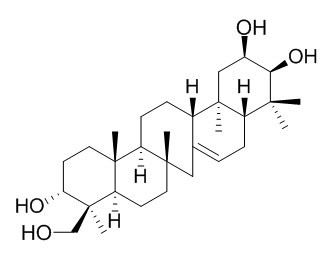Providing storage is as stated on the product vial and the vial is kept tightly sealed, the product can be stored for up to
24 months(2-8C).
Wherever possible, you should prepare and use solutions on the same day. However, if you need to make up stock solutions in advance, we recommend that you store the solution as aliquots in tightly sealed vials at -20C. Generally, these will be useable for up to two weeks. Before use, and prior to opening the vial we recommend that you allow your product to equilibrate to room temperature for at least 1 hour.
Need more advice on solubility, usage and handling? Please email to: service@chemfaces.com
The packaging of the product may have turned upside down during transportation, resulting in the natural compounds adhering to the neck or cap of the vial. take the vial out of its packaging and gently shake to let the compounds fall to the bottom of the vial. for liquid products, centrifuge at 200-500 RPM to gather the liquid at the bottom of the vial. try to avoid loss or contamination during handling.
Yakugaku zasshi journal of the Pharmaceutical Society of Japan,1974, 94(8):970-90.
Chemotaxonomic studies on the triterpenoids of Lycopodium plants (Japanese)[Reference:
WebLink]
Fifty-one samples of Lycopodium plants (mostly Japanese species), including 17 species and 3 varieties, were collected and their triterpenoid constituents were examined firstly by comparing microchemically and then characterized by isolating them after alkaline hydrolysis.
METHODS AND RESULTS:
Discussions are made on thin-layer chromatography and chemotaxonomy of lycopodium triterpenoids, isolation and characterization of triterpenoids constituents, relationship between location of growth and the constituents, and relationship between species and the constituents. All the plants examined contained triterpenoids of serratane group or its assumed precursor, α-onocerin, the former including 13 new triterpenoids, 16-oxoserratenediol, 16-oxo-21-episerratenediol, 16-oxodiepiserratenediol, 16-oxoserratriol, 16-oxolycoclavanol, lycocryptol, 21-epilycocryptol, diepilycocryptol, Lyclaninol, lyclanitin, 16-oxolyclanitin, lycernuic acid-A, and lycernuic acid-B, and two new glycosides of serratenediol and tohogenol. A new bisnortriterpenoid, clavatol, was isolated from L.clavatum. All these Lycopodium plants can be divided into three classes according to their major triterpenoids ; α-onocerin (L.clavatum, L.sitchense, L.obscurum, L.casuarinoides, L.inundatum), serratenediol (L.serratum, L.somae, L.cryptomerinum, L.chinense, L.sieboldii, L.fargesii, L.fordii, L.cernuum, L.phlegmaria), and 21-episerratriol (L.annotinum). Some of them (L.sitchense, L.annotinum, L.cernuum, and L.complanatum) showed variation in constituents depending on the locality of growth.
CONCLUSIONS:
Particularly, L.complanatum collected in Hokkaido contained α-onocerin as a major component, while the same plant from Taiwan did not contain α-onocerin but had 21-episerratriol as the major triterpenoid. Some plants of different species (cf. L.fargesii and L.fordii) were not distinguishable by their triterpenoid constituents suggesting their close relationship.



